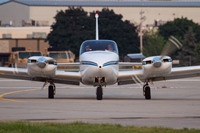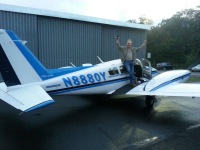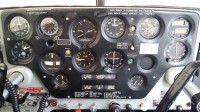Hello,
I have a Factory Turbo twinco PA39 built in 1970. I habe a few problems with the turbo. The MP is not so high in FL160 and above (only 24 to 26 MP). We are about to look for leaks everywhere and already found a few. But what we discover today, is really interessting. At the bottom of the engine are two hoses-link which are connected und go to an adapter at the cowling. When we blow intos these hoses, we here a hiss in the induchtion of the air filter. That means, if the turbo starts to blow air in the air filter/Engine, a few of the over-pressure goes out through these to hoses and reduces the MP. See picture "red arrows". Is that OK ? In my opinion, these to hoses does not make really sence. I would prefer to close these two hoses to have more pressure/power for the engine in high altitude. Does the after market Turbo Twincos have these hoses as well? For what are these two hoses good for?
Hoses at the bottem off the engine
9 posts
• Page 1 of 1
Re: Hoses at the bottem off the engine
Those are sniffle valves. They allow excess fuel from priming to dump overboard. If they are functioning properly, the check valve/ball in them should be sucked closed (via vacuum pressure) when the engine is running.
-

Timothy Poole - Posts: 122
- Joined: Tue Oct 28, 2014 8:43 pm
- Location: KVKX
Re: Hoses at the bottem off the engine
Thanks, but what happens, when the turbo starts boosting the engine? Then there is not vacuum any more to suck a ball, there is an over presure, which means in my opinion, that a part of the over-pressure coming from the turbo goes away over this valve and it will less pressure left for the engine.
In other words, when I close these to hoses/valves, nothing serious happens, except that flooding the engine is more possible than with these valves?
In other words, when I close these to hoses/valves, nothing serious happens, except that flooding the engine is more possible than with these valves?
Twin Comanche Turbo, N8880Y, 1970 ICS 18741
-

Wolff Ehrhardt - Posts: 7
- Joined: Tue Apr 19, 2016 10:58 am
Re: Hoses at the bottem off the engine
Or more damaging potential backfires from accumulated fuel and other gunk (condensed fuel dye) in there...
How much (boosted) manifold pressure do you think it ought to have at 16,000 feet? Is there an operating table for that?
I'd be reluctant in the extreme to pinch those off without more info. Having them checked and replaced if they aren't operating properly (per the applicable maintenance manual) seems like a good place to start.
You point seems correct to me though. At high altitudes, if the boosted manifold pressure at that intake is higher than ambient, then those valves would be open and pressure would be lost at that point. Perhaps turbo charged engines use a differently actuated sniffle valve and you have the wrong ones?
How much (boosted) manifold pressure do you think it ought to have at 16,000 feet? Is there an operating table for that?
I'd be reluctant in the extreme to pinch those off without more info. Having them checked and replaced if they aren't operating properly (per the applicable maintenance manual) seems like a good place to start.
You point seems correct to me though. At high altitudes, if the boosted manifold pressure at that intake is higher than ambient, then those valves would be open and pressure would be lost at that point. Perhaps turbo charged engines use a differently actuated sniffle valve and you have the wrong ones?
-

William Hughes - Posts: 97
- Joined: Mon Apr 21, 2014 9:23 pm
- Location: Saskatoon, SK
Re: Hoses at the bottem off the engine
Wollf,
Those valves are technically manifold drain valves. They get gummed up and need to be checked at annual inspection. If you can blow into them, then the check valve is stuck. One can try soaking in acetone to see if they clean up. I keep one or two spares. The p/n is 492-091. The valve will also limit, but might not entirely block, the flow of air outwards when the turbos are running. However, that is a very small leak and you would not notice much difference. If you block them off you are asking for a manifold fire or the mother of all backfires through the induction system. Don't go there. Buy new valves if necessary.
IMO, if a turbo can maintain 25" and 2500 rpm at 16,000, you are doing pretty well and probably not worth spending money on chasing turbo problems until it drops below that. That, of course, is merely my opinion.
Those valves are technically manifold drain valves. They get gummed up and need to be checked at annual inspection. If you can blow into them, then the check valve is stuck. One can try soaking in acetone to see if they clean up. I keep one or two spares. The p/n is 492-091. The valve will also limit, but might not entirely block, the flow of air outwards when the turbos are running. However, that is a very small leak and you would not notice much difference. If you block them off you are asking for a manifold fire or the mother of all backfires through the induction system. Don't go there. Buy new valves if necessary.
IMO, if a turbo can maintain 25" and 2500 rpm at 16,000, you are doing pretty well and probably not worth spending money on chasing turbo problems until it drops below that. That, of course, is merely my opinion.
Kristin
-

Kristin Winter - ICS member

- Posts: 1299
- Joined: Tue Aug 09, 2005 5:21 pm
- Location: Northern California
Re: Hoses at the bottem off the engine
How much (boosted) manifold pressure do you think it ought to have at 16,000 feet? Is there an operating table for that?
Very easy. In FL160 a non turbo would bring aprox 14 MP. If I turn the turbo to 28 MP (turbo cruise) the MP difference will be 14.
Very easy. In FL160 a non turbo would bring aprox 14 MP. If I turn the turbo to 28 MP (turbo cruise) the MP difference will be 14.
Twin Comanche Turbo, N8880Y, 1970 ICS 18741
-

Wolff Ehrhardt - Posts: 7
- Joined: Tue Apr 19, 2016 10:58 am
Re: Hoses at the bottem off the engine
Thanks Kristin,
The POH says that turbo cruise should be possible up to FL 20.000 with MP 28/2400. But I only reach 26/2400 in FL140.
We will check the valves. Thanks for the tip with the acetone.
The POH says that turbo cruise should be possible up to FL 20.000 with MP 28/2400. But I only reach 26/2400 in FL140.
We will check the valves. Thanks for the tip with the acetone.
Twin Comanche Turbo, N8880Y, 1970 ICS 18741
-

Wolff Ehrhardt - Posts: 7
- Joined: Tue Apr 19, 2016 10:58 am
Re: Hoses at the bottem off the engine
For my understandIng. To avoid backfire in the induction System, the sniffel valves must be open. When the engine runs, I could close theoreticly the valve and I do not get the risk of back fire until I stop and Restart the engine.
Twin Comanche Turbo, N8880Y, 1970 ICS 18741
-

Wolff Ehrhardt - Posts: 7
- Joined: Tue Apr 19, 2016 10:58 am
Re: Hoses at the bottem off the engine
I had a Rayjay mooney m20c prior to my recently purchased twin Comanche. I was able to make the Wastegate tight with a dremel tool and fixed all the leaks and it would boost 25 at 2500 rpm at 25000 feet. My Comanche would loose boost on both engines at14000 feet so I simply replaced the seal in the flapper door and on the alternate air door both sides. Then I realized the air cleaners are pressurized. Huge leaks! Now without fine tuning the Wastegates yet I'm getting 24 at 24000 at 2500 rpm. At 2600 rpm it will do 25 mmHg. Btw my inlet air temp with new monitors was 127 Fahrenheit with negative 40 outside. I did not feel an intercooler was worth the hardware but up high it might be. I'm not seeing much on this topic. Critical altitude is the level sea level power is still available. My definition would be the altitude 25 mmHg can be gained at 2500 rpm. Would sure like to know how close to optimum I have it. Douglas
- Douglas Crane
- Posts: 2
- Joined: Thu Sep 07, 2017 2:53 pm
9 posts
• Page 1 of 1
Return to Maintenance - Powerplant
Who is online
Users browsing this forum: No registered users and 13 guests
